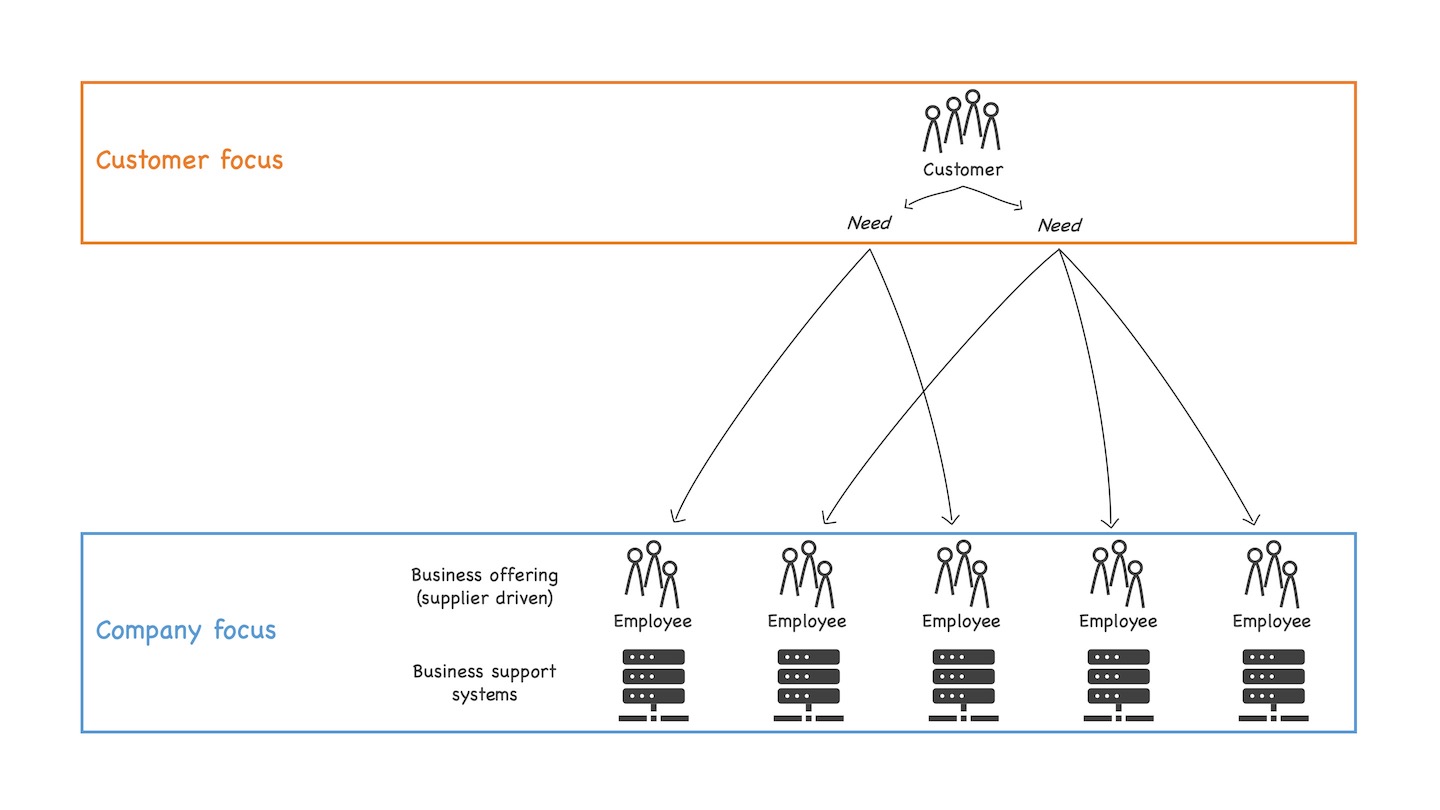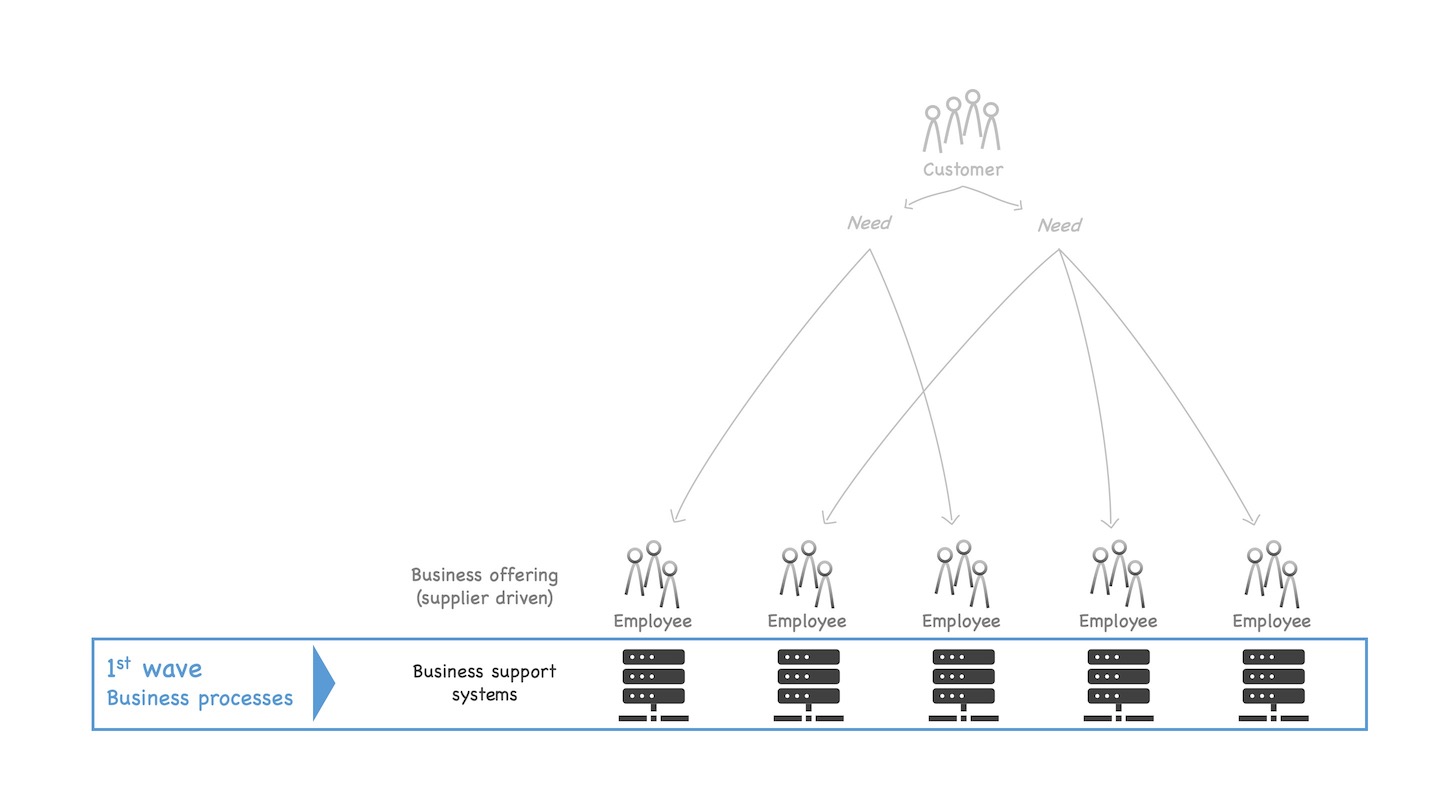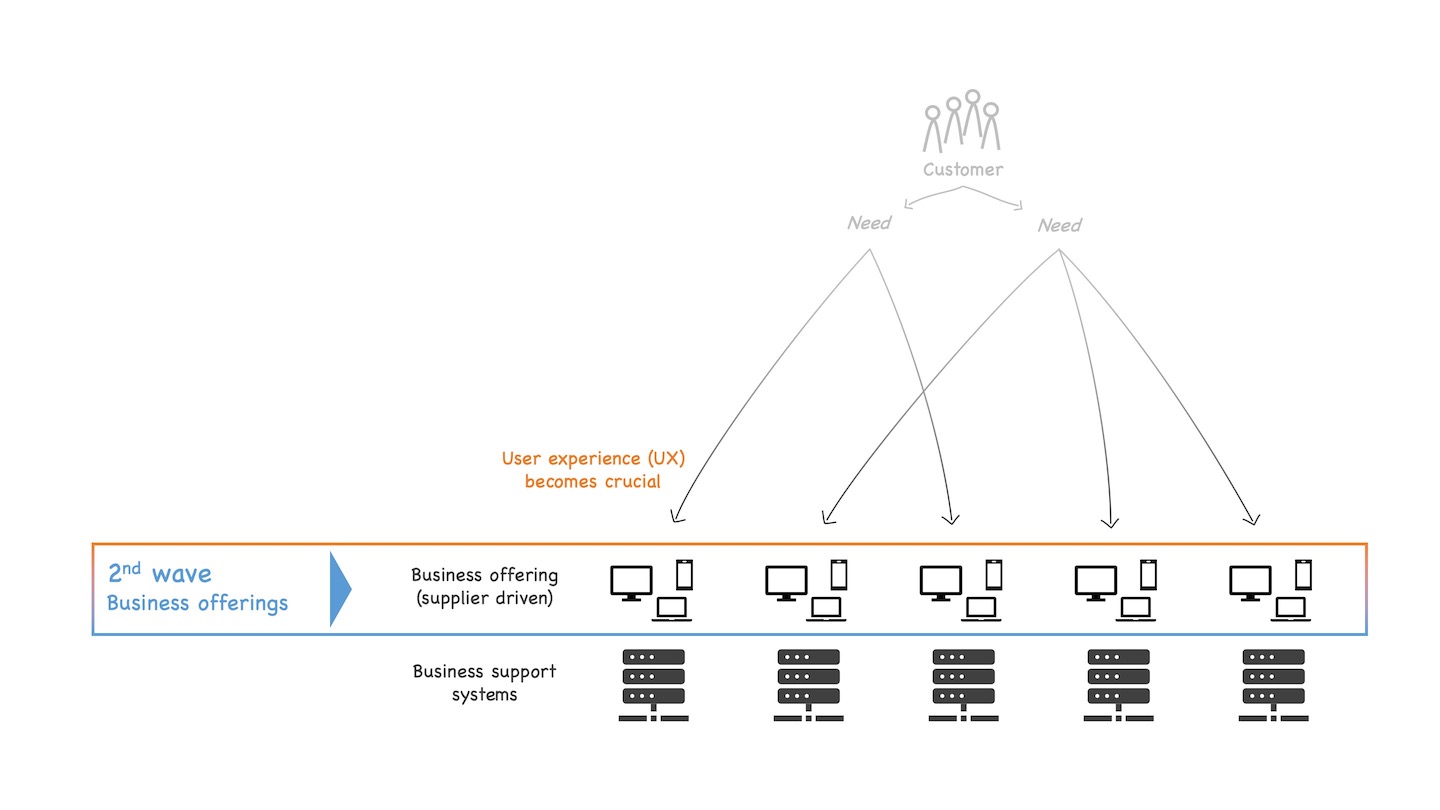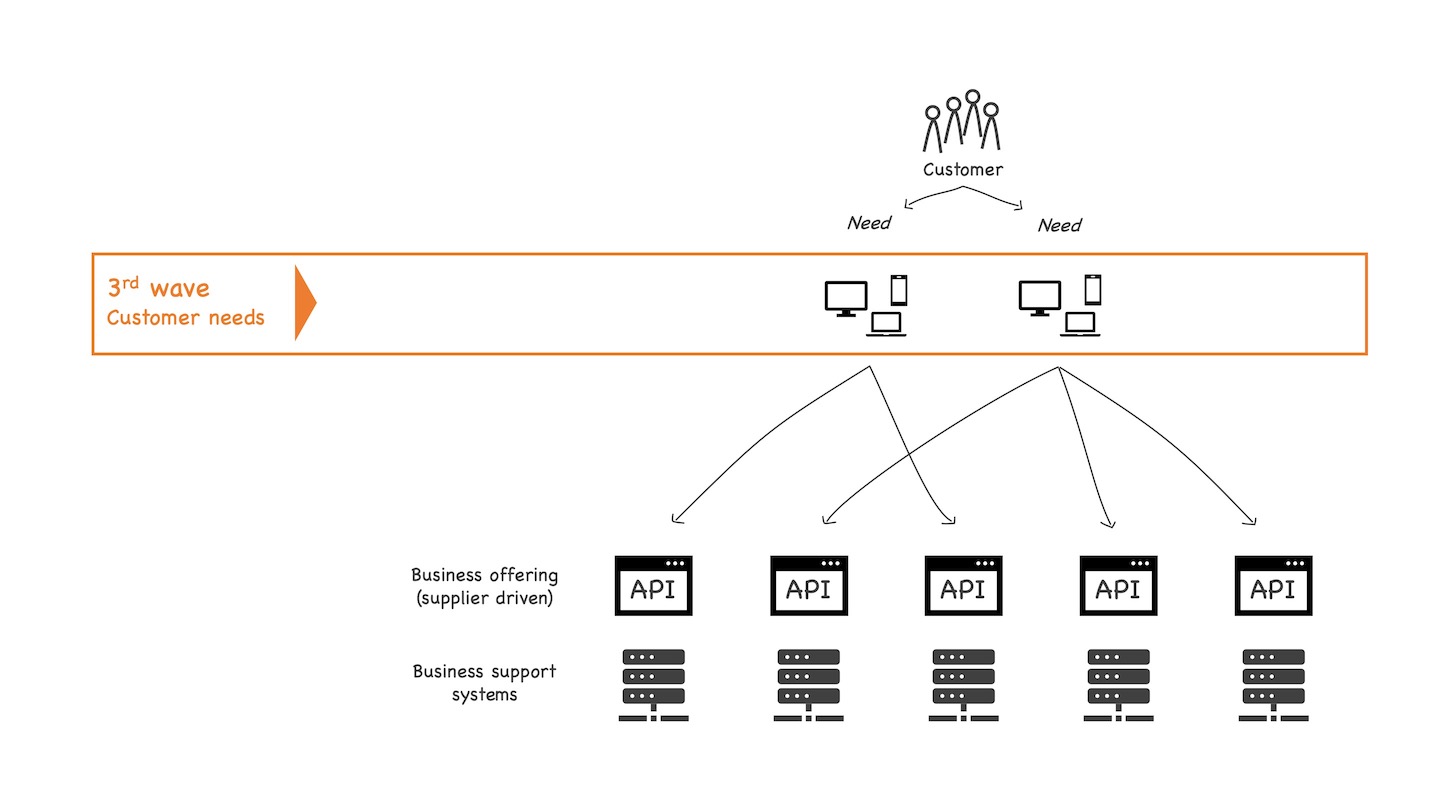The three waves of digital transformation
Digital transformation without the hype, smoke and mirrors

The three waves of digital transformation
“Digital transformation” is probably one of the most overstressed terms of the last years - not only in IT, but also everywhere else: in the news, the media, every conference, everywhere. You just cannot not escape it. But what makes it really annoying is that most people who talk about it do not seem to have any proper idea what it actually means.
One manager proudly announces that they are working on an electronic customer file and thus are a digital leader. The next one talks about their e-commerce strategy, the third one about their cloud strategy and yet another one about platforms and API economy. And of course all are self-proclaimed leaders of digital transformation.
Obviously, all of them talk about very different things. But what is digital transformation truly?
I am not sure if there still is a simple answer to this question. Popular topics tend to become a plaything of multiple interests. As a result the topic becomes blurry and the discussion filled with a lot of blah.
Therefore, I am afraid I will not be able to present the ultimate truth about digital transformation to you – and admittedly I do not even try. Yet, I can offer you what I learned about the topic so far.
As I understand it, digital transformation is about two things:
- Technology evolution
- Business evolution
and how those two evolutions affect each other. Based on my observation, the digital transformation takes place in waves. Many small waves sum up to a few big waves. The big waves are defined by their effect on the business, not the technology.
For me, that is the core of “digital transformation”: something non-technical becomes digitally transformed, i.e., IT becomes part of something that did not include IT before.
From supplier to consumer

Isolating these “somethings” make it a lot easier to understand where you are in the digital transformation. When pondering these business-related “somethings”, I realized that they be nicely aligned on a value-delivery chain from supplier to consumer, i.e., company to customer.
On the one end are the customers. They have needs and usually need to go to several companies to fulfill their needs. Here is a simple example for illustration purposes – not necessarily related to digital transformation, but easy to grasp:
I have a heating at home. I do not really care about the heating. Nor do I care about the energy supplier, the maintenance company or the chimney sweep. My actual need is on a different level: I want to have a comfortable temperature inside, even if it is cold outside. That’s it. No heating, energy supplier or anything else – only warm inside, even if cold outside.
Still, I have to go to several companies, buy stuff from them, make contracts with them and more to get my need fulfilled. We will see later how the digital transformation starts to change that (unfortunately not for that use case, I am afraid).
But first, let us complete the picture. On the other end, there are the companies creating and delivering their business offerings (products and services).
Companies focus on their offerings, while customers focus on their needs. While having a very different focus, both parties need to meet somewhere. Otherwise the needs are not fulfilled and the offerings are not sold. The digital transformation changed (and still changes) massively where and how both parties meet.
I personally differentiate 3 waves. Let us go through them one by one.
1st wave: Digitization of business processes

Before the rise of IT, the whole value-delivery chain was non-digital, usually manual work beyond the shop floor. This high ratio of manual work in the order and delivery process limited how fast and how much a company could deliver because manual work cannot be scaled and accelerated reasonably beyond a certain point.
This is where the first wave of digital transformation set in. The first wave addressed the automation of business processes by implementing and connecting business support systems. The wave started roughly 40 years ago 1 and had its peak about 20 years ago. Today the wave is mostly completed.
The manager from the beginning who talked about implementing an electronic customer file referenced this wave – rather being a transformation laggard than a leader.
This wave is mostly invisible for the customer. It does not change how they fulfill their needs or interact with a company. The interface remains human, usually an employee of the company or an attached distributor.
From a customer’s point of view the only difference is how fast and how much a company can deliver as the automation of business processes helps to speed and scale up the value-delivery processes.
2nd wave: Digitization of business offerings

The second wave felt quite different from a customer’s point of view as it changed how customers accessed business offerings. It started about 20 years ago with the rise of e-commerce solutions. For the first time the customers were able to interact with companies directly using IT-based solutions. They no longer needed to approach a sales representative.
This did not only change shopping and retail dramatically. It affected all kinds of supplier-consumer interactions as more and more product and service offerings of the companies became available online.
This evolution received an extra boost with smartphones. Regarding business offerings, smartphones were complete game changers:
With mobile devices the customer does no longer need to go to the Internet. The Internet goes with the customer.
Think about that from a product manager’s point of view: the possibilities to engage with your customers explode and you are able to reach them in basically any life situation if you offer the right things. Unfortunately – at least in Germany where I live – most companies have not yet grasped this effect of mobile devices.
The mobile revolution additionally enabled new hybrid business offerings like, e.g., Uber, Airbnb or Delivery Hero which combined IT-based and non-IT-based offerings in a novel way. But also all other Internet-based offerings benefited a lot from the mobile revolution.
A consequence of IT being part of the customer interface is that UX (User eXperience) design became a crucial aspect of product and software design.
The second wave is currently at its peak. If people talk about “digital transformation” today, they usually mean this wave.
As written in the beginning of this section: from a customer’s point of view, the second wave changed the interaction interface and patterns a lot. Yet, the customers usually still needed to interact with several companies to fulfill their needs.
3rd wave: Customer-need based offerings

This changes with the third wave of digital transformation. It just started and builds on the results of the second wave. The second wave meant that the business offerings of a company became available via an IT-based user interfaces (mobile or web based). If a business offering is available via IT, it can also be exposed via an API.
This is exactly what happens these days: companies make their business offerings available via APIs, often talking about API economy and platforms. Still, from what I see most companies have not yet understood the consequences of this movement. Most companies hope to be early enough to take over the control of the platform ecosystem in their home domain (, like, )e.g., retail, insurance, banking, etc.), assuming that the market in their domain will not change otherwise.
But that is not the consequence of the third wave. Having all the business offerings from all the different domains available via API, something else starts to happen: novel, previously impossible, even unthinkable business models emerge. The related business offerings consume the required basic business offerings via API in order to fit the actual needs of the customers better.
To illustrate this evolution using my little (non-digital) example from the beginning: The third wave means that a (new) supplier will offer a novel service that guarantees that it is warm inside, even if it is cold outside. And if should not be warm inside for a reason, they guarantee it will be warm again after two hours latest.
That company will consume several other offerings from heating manufacturers, energy suppliers, maintenance companies and the chimney sweep. Maybe the company will also take out some kind of insurance policy do hedge the risk of failing heatings.
Being the customer, it is not relevant for me which offerings the company bundles to fulfill my need. I just pay a monthly fee and the company takes care of the rest. Maybe I would like to have a “green energy” option (which costs a bit more per month). But that is basically it.
If I additionally allow the company to install some sensors (receiving a discount on the monthly fee), they can even maintain the heating before it breaks.
If the heating should still break for a reason, I also do not care if they immediately fix the heating or set up a bunch of fan heaters (making sure that I do not pay extra for the potentially higher energy costs) and fix the heating later. As a consumer I only care that my need is fulfilled at a reasonable price and quality.
Thus, with the third wave of digital transformation, the consumer needs get addressed for the first time, i.e., the point where customers and companies meet changes radically with the third wave.
Consequences of the three waves
The first wave was about efficiency – delivering more and faster without compromising quality. From a supplier’s point of view, the first wave was a huge boost in productivity. From a consumer’s point of view is was just a bit faster and more reliable service delivery.
The second wave changed the interaction modes and patterns between supplier and consumer. Consumers can interact with a supplier through IT at any time from wherever they are. From a supplier’s point of view this means a lot of new options, but also a lot of increased uncertainty. Companies need to learn which offers customers accept on which communication channels and how to continuously improve the usage experience.
To be successful in such a setting, the traditional IT practices from the first wave do no longer work because it is not possible anymore to anticipate upfront which options will create value, i,e, will be accepted by the customers. Instead, a continuous feedback cycle with the customer is required – which many companies have not yet implemented. 2
The third wave lifts uncertainty to a whole new level from a supplier’s point of view. To actually address the needs of the customers they need to combine offerings from several domains to create a novel customer-need based offering. Besides the challenges of the second wave this means, the companies also need to understand domains they do not yet know and the needs of their (future) customers. I usually call this “uncertainty to the square”.
When looking at most of the companies that currently talk about API economy and platforms, I do not see that they actually prepared for that novel level of uncertainty. Most of them act as if they still were in the first wave of digital transformation. Thus, I expect interesting times in the near future.
I will write in more detail about the consequences of uncertainty, how to deal with it and what this means for IT. But for today, I would like to leave it here and hope that this post gave you a few ideas to ponder.
-
Before that, IT also supported the business but usually only smaller parts of it like selected business functions, not whole processes. ↩︎
-
This is a similar issue like the transition from industrial to post-industrial markets (see this post) for a brief explanation of pre-industrial, industrial and post-industrial), which also requires a different IT operation mode. I will write about that topic in more detail in some later posts. ↩︎






Share this post
Twitter
Google+
Facebook
Reddit
LinkedIn
StumbleUpon
Pinterest
Email